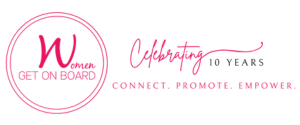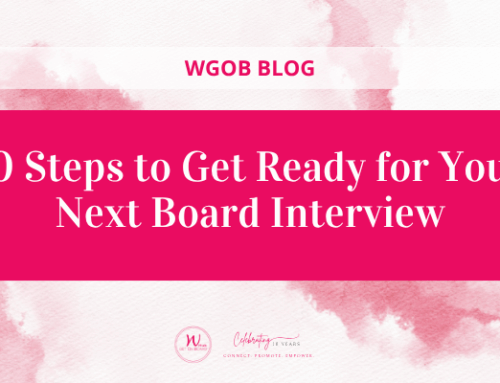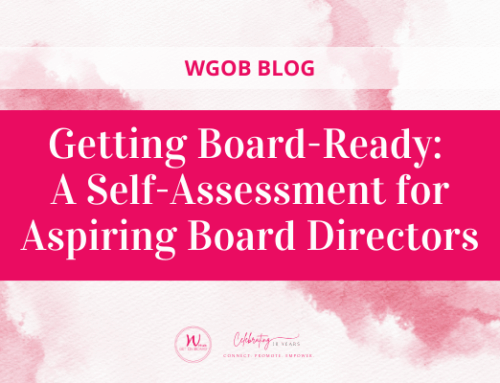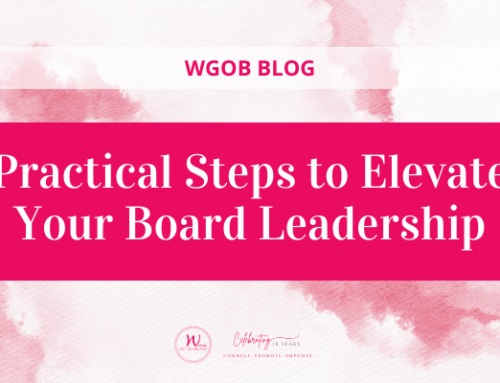According to a Harvard Business Review article called “Research: When Women Are on Boards, Male CEOs Are Less Overconfident”, having more women on boards yields better results for shareholders because “having female board members helps temper the overall confidence of male CEOs, improving overall decision making for the company.”
Women Get On Board supports the findings of this study: having more women on boards leads to better results for the businesses they represent. That is why our mandate is to connect, promote, and empower more women to corporate boards. It’s also why I am sharing my board advice in this 4-part series called “How to Get Yourself on a Board.”
If you have been following the first 3 blogs in this series, you have learned how to “Master the Foundations”, “Position Your Board Offer”, and “Get Board Interviews”. The final blog in this series ties all of these elements together by showing you how to ace your board interview.
In today’s blog, I provide my top ten (10) tips from my work with Women Get On Board and my own governance experience on how to best prepare for your board interview.
1. Prepare, prepare, prepare.
Like a job interview, you want to come prepared to your board interview. Make sure you know which members of the board you will be meeting with. Understand their respective experience and skills (review the current board composition), as well as how you might be connected to them. Find out who the independent board members are and what the ratio of executive to non-executive board members is. It’s also important that you understand the board’s specific and unique challenges, why there is a board vacancy, and if they have term/age limits. Also, what is the board recruitment process? How many board members are they recruiting for? What specific skills/expertise is being considered?
2. Gain a strategic understanding of the company.
Now that we are in the midst of COVID-19, this step is more critical than ever. During the pandemic, what challenges or opportunities is the company facing? Are they going through restructuring or solvency or major transformation in the business model?
There are three phases during COVID-19 that companies are facing: respond, recover and thrive. Understand what phase the company is in and understand how the board is coping. This recent blog called “How Boards are Coping with COVID-19” highlights how boards are “a crucial role of any board is risk management. This responsibility includes setting the appropriate risk level, monitoring management’s actions against that benchmark, scanning the horizon for potential problems and helping management deal with potentially value-destroying events when they occur. Covid-19 makes this task much more difficult. Not only has the pandemic raised risk levels significantly, but it has also transformed the landscape, revealing entirely new categories of risk. For example, risks pertaining to cybersecurity must be revisited in light of the “new normal” of remote working. Regulatory risks will also require reassessment as governments mull increased intervention to help mitigate the crisis.”
3. Research, research, research.
Do your due diligence. Go on SEDAR (www.sedar.com) and read the company’s latest annual report, annual proxy circular, quarterly filings, and press releases and analyst reports. Also check out the company’s social media and what is trending online about the company. For a good overview of questions and issues potential directors should consider before joining a board, refer to Appendix B of CPA Canada’s “20 Questions Directors Should Ask about Building and Sustaining an Effective Board” written by Elizabeth Watson.
4. Know your board value proposition.
Knowing your board value proposition means understanding the value you bring to a board. For example, my board value proposition is “I have entrepreneurial, financial, and governance expertise with high growth and transformational companies in technology, retail, consumer and cannabis sectors.” It should include your top 3 skills/expertise, the type of the companies you can add value to, and the specific industry sectors you have experience in. For more information see my blog on Preparing Your Board Resume.
5. Understand conflicts.
Ask for their corporate calendar, which is the board/committee meetings over the next 12 months or so, and make sure it doesn’t conflict with your current commitments. Also ensure that you have the time to commit to this board. Are there other conflicts that you have to be concerned with like your current employer, financial or related parties? For example, if you’re looking for an opportunity for a cannabis board, make sure that you’re not conflicted from a supply or demand side. Another consideration is if there are any interlock holdings, in which two board members serve on multiple boards together, leading to potential conflicts of interest.
6. Understand the culture of the board.
Where do you fit in? Look at the current board composition and their board diversity policy. What would it mean for you if you are being considered to be the “first” woman on the board? Ask questions about your fit. Find out how the board works together. Is it collegial? Does the board evaluate its own performance?
In 2015, the importance of understanding board culture was cemented for me. I went to a board interview with the CEO of a public company in the retail sector. The company had recently been under pressure because they didn’t have any women on their board. As soon as I walked in, the first thing the CEO said was, “You know, I’m not interviewing you because you’re a woman.” I paused realizing I had two choices. I could leave politely, or I could move forward. Either way, I knew I wasn’t interested in joining the board of this company as it would not be the right fit for me. I responded, “I’m not here because I’m a woman. I’m here because I can add value to your board, so let’s talk strategy.” We proceeded to have a 2-hour strategy meeting, and I politely declined any further board interviews with that company. I didn’t want to be the token woman and I knew it wasn’t going to be the right board culture for me.
7. What board committees exist?
What committees does the board have? And which of those would you consider joining? Most importantly, which committees could you contribute the most value? Is the board considering bringing you on because they would like you to chair a specific committee, or because you are being groomed to chair a specific committee? For example, I recently joined a board and was tapped to chair the audit committee from day one because of my public company financial reporting experience.
8. Know your expected contribution.
Why did the company identify you as a board director candidate? What is their expectation of you going forward? It is important to ask directly, “why was I considered to join this board?” Sometimes you think you know why you are being asked to join a board, but the real reason is slightly different. For example, when I was asked to join a Departmental Audit Committee (DAC), I asked the Chief Audit Executive (CAE) why I was considered for that role. The CAE said that reason why was that my board resume reflected my corporate transformational experience.
9. Compensation.
Review their board compensation in their annual proxy circular. Is there an expectation to purchase shares? Is the compensation in line with your expectation? How often do they do a board compensation review? If it is a private company, you should ask what the board compensation structure is and determine if it is in line with the market comparables (comps). You can review and compare board compensation trends here: “Canadian Spencer Stuart Board Index 2019.” It’s also important to make sure that you have a good understanding of the time expectation vs the compensation. In my experience, you should prepare to spend up to 300 hours per year on a corporate board, depending on priorities of the company at any given time.
10. Practice, practice, practice.
The final and potentially the most important tip is to practice, practice, practice! Here’s where you prepare for the kinds of questions you will be asked and make sure you have a good understanding of the company. You can ask a good friend or respected colleague to help you prepare for 30 minutes. It is especially useful if the person you ask understand board governance and board interviews. Don’t be afraid to ask for help!
Looking to learn more about how to get yourself on a board? Consider registering for the Women Get On Board Getting Board Ready (GBR) Program, delivered in collaboration with LHH Knightsbridge. The GBR Program is designed to empower women on their journey to land their first corporate board seat. The GBR program offers practical and actionable insights in a combination of micro-learning, virtually facilitated discussion by experts, practical homework, and hands-on support. Learn more: https://womengetonboard.ca/programs/







